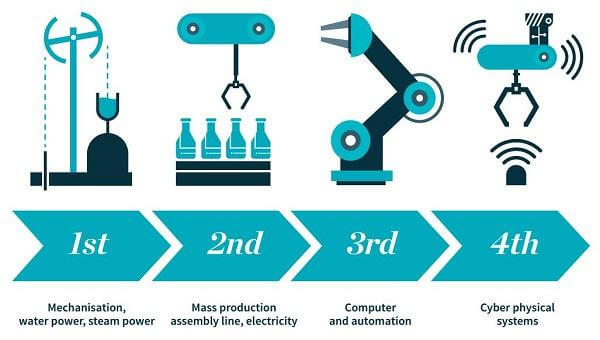Adapt or Die – Cities and Digitalisation
With tabloid headlines full of doom and gloom about the number of jobs that will be destroyed by digitalisation, and policy makers being fearful of the whole notion of disruption, some cities may be wondering about this 4th industrial revolution or industry 4.0, and what’s in it for them.
This article aims to explore why digitalisation must be seen as an opportunity, not a threat, for Europe’s towns and cities and – to take the TechTown network’s mantra – why cities and businesses need to adapt or die.
First, some definitions…
For many this is a complex, often unfamiliar and therefore somewhat bewildering landscape. So it’s important to provide a few explanations of key terms before delving deeper.

4th industrial revolution
This phrase was coined by Professor Klaus Schwab, Founder and Executive Chairman of the World Economic Forum in his book of the same title.
Previous industrial revolutions liberated humankind from animal power, made mass production possible and brought digital capabilities to billions of people. This Fourth Industrial Revolution is, however, fundamentally different. It is characterized by a range of new technologies that are fusing the physical, digital and biological worlds, impacting all disciplines, economies and industries, and even challenging ideas about what it means to be human. The resulting shifts and disruptions mean that we live in a time of great promise and great peril.
Industry 4.0.
Mckinsey defines industry 4.0. as ‘the next phase in the digitization of the manufacturing sector, driven by four disruptions: the astonishing rise in data volumes, computational power, and connectivity, especially new low-power wide-area networks; the emergence of analytics and business-intelligence capabilities; new forms of human-machine interaction such as touch interfaces and augmented-reality systems; and improvements in transferring digital instructions to the physical world, such as advanced robotics and 3-D printing’.
Source; University of Sheffield
Digital disruption
Digital disruption is a transformation that is caused by emerging digital technologies and business models. These innovative new technologies and models can impact the value of existing products and services offered in the industry. This is why the term ‘disruption’ is used, as the emergence of these new digital products/services/businesses disrupts the current market and causes the need for re-evaluation – source Oxford College of Marketing
Why is this relevant to cities? Keep reading…
These definitions and concepts are complex but basically what we all need to recognise is that digitalisation is going to happen. It’s often described as an ‘unstoppable juggernaut’ as it’s going to happen quickly. Businesses really don’t have a choice. They can do nothing and risk fragility and long term almost inevitably die. OR they can be proactive, adaptive, disruptive, agile and hopefully that will enable them survive and thrive. It really is as simple as that. Disruption is only a threat to those who choose to ignore it or try to fight it. Those who embrace it find that it can benefit their business in lots of different ways and contribute success and growth.
Cities have a clear role to play supporting the business community. If their businesses can’t or won’t adapt, city economies will suffer.
But it’s destroying jobs!
Digitalisation is not the same as automation. Automation is a start. Using information from automated processes is where digitalisation kicks in and starts to reap reward. This is not about reducing headcount or destroying jobs. It is more helpful to think of it as destroying non-value-adding tasks or roles. This enables humans to focus on the parts of the business that add value. So yes, it will have a massive impact on the future workforce, and yes, there is much to be done to explore how the existing workforce can be effectively redeployed rather than unemployed. But that is a whole other topic – touched upon in URBACT’s own Job Generation and New Urban Economies Capitalisation series.
Here the focus is more on the role of cities in digitalisation itself.
So why is this important to cities?
The most cited examples of digital disruption are often the least helpful when it comes to considering the potential positive impacts on urban development. Uber and Airbnb, for example, may have revolutionised peoples’ ability to travel within and between cities but they have also provided real challenges in urban development terms, for instance affecting rental prices and employment conditions for citizens. URBACT itself has published a number of relevant blogs and articles on this topic – focusing e.g. on the role of cities within sharing economy and the gig economy.
A number of more positive examples of digital disruption and public sector interventions were discussed at the TechTown network event in Gävle, Sweden in June 2017. They show how digitalisation can help solve long term economic channels like productivity levels, business efficiency and logistics, and how urban policy interventions can help to sustain development and impactful delivery.
3 of these are summarised below:
KickStart
KickStart, run by a national cluster called Fiber Optic Valley, is a pilot project covering 10 Swedish Cities. Funded by both the public and private sector, the overall aim is to increase the understanding, willingness, pace and volume of digitalisation.
The project works with 10 companies in each of the 10 cities. Over the course of 4-6 weeks the companies invest 2 days (1 full day + 2 x half days) in workshop activities which aim to help them to identify and understand how digitalisation can help them to increase productivity and efficiency. The emphasis is very much upon helping the companies to identify their problems – their needs – rather than leaping towards a solution. In 90% of cases the tech solution exists; in the other 10% there is a start up eager to find it – so this is as much about changing mindsets as it is about the technology itself. Often there is a reasonably simple ‘fix’ and Kickstart can play a useful role in brokering relationships between companies which have an identified need and those which have already found a solution.
With the pilot project proving to be very popular with business, and reaping tangible reward in terms of productivity and efficiencies, there is now a plan to roll the programme out across 100 Swedish towns and cities.

Connected manufacturing
In 2017 Barnsley Council (leaders of the TechTown network) launched a programme to support digitalisation of existing local manufacturing companies whilst simultaneously enabling digital companies to grow. Connected Manufacturing brings the manufacturing and digital communities together to encourage adoption of digital technologies that can improve manufacturing productivity and competitiveness. This is especially important given that advanced manufacturing is a key industrial sector.
A trusted Barnsley business advisor with a manufacturing background, supported by an independent digital consultant, visited local manufacturers, many of which were family run firms using old mechanical equipment, to help them to identify and explore their industrial challenges and opportunities to improve operational efficiencies through (often small and inexpensive) digital changes. The findings fed into a big event which brought manufacturers face to face with small digital start ups, SMEs and entrepreneurs.
Case Study
Naylor Industries in South Yorkshire, UK is a fourth-generation family business with a 127 year history. The company has five factories that manufacture building and construction products, such as clay pipes and plastic drainage systems, and exports around the world. With the recent global economic challenges and rising energy costs, as a large energy user, Naylor realised they needed to change. They formed an action team and partnered with Siemens Digital Factory to analyse the power usage at their factory sites. Seeing the benefits of real-time data to inform operations and production, Naylor is now digitally enabling their new and existing facilities for an intelligent data-driven future.
Connected manufacturing
Innovate UK
Transformation through technology
Target IS
How IoT changes manufacturing
Smart software to build world class suply chain
Everybody wins – brokering relationships between large and small
Sandvik is a global materials engineering company with headquarters in the Gävleborg region in Sweden. Last year it worked with a ‘business tailor’ from the regional incubator (Movexum – co funded by local and regional government and a range of private partners) to identify its digitalisation needs. In short the Sandvik site covers a massive industrial area equivalent in size to 800 football pitches. Sanvik was keen to understand how digitalisation might improve efficiencies in terms of movement of materials into, and around, the site. Movexum brokered links with a local tech start up called Invotech and the start up and corporate co created a new GPS system which supports truck drivers and management with the positioning of materials. The impact has been massive for both companies – Sandviq has improved safety and productivity; Invotech has won a large new industrial client which has served as a gateway into a global market place, not to mention unrivalled PR and media exposure.
None of this would have happened without the intermediary – in this case a regional incubator.
So what role can cities play?
Hopefully by now it is becoming clearer that urban economies will be impacted by digitalisation. But what does this mean for cities in practice? What sorts of activities could they realistically do to make sure that their businesses are able to positively benefit from digitalisation?
Messenger
Cities can reach out to their business community – who are as much their customers as individual citizens – and help them improve their understanding and benefits of digitalisation (as opposed to automation). It is important that existing businesses realise that this really is not about reducing headcount or destroying jobs but about changing the nature of tasks and redeploying existing workers. So cities have a role to play in removing the ‘fear’ of disruption and digitalisation with existing companies.
Broker and enabler
It is clear from the examples above that cities may have a role to play in funding or even acting directly as an honest broker, a navigator or catalyst which brings together large and small companies to achieve benefit for both and for the local economy. It may also be possible to help incumbents (established companies) to identify and then be led by their actual digitalisation needs and to find (local) tech start ups which can address them (in 90% of cases the tech solution exists; in the other 10% there is a start up eager to find it). So this brokerage role can help companies to come together to co-create ‘win-win’ relationships between large and small. It can also help peer to peer learning – cities can identify and share good local examples of positive digital disruption and stop policy makers focusing on some of the better known disruptive brands.
There is also a brokerage role around the theme of skills and talent – local authorities can, for example, support companies to identify local talent and embed digital skills into local training provision (for young and old alike)
Early adopter
Cities can – and probably should – lead from the front when it comes to digitalisation. It may not seem obvious – and it certainly won’t be easy – but they can ‘walk the talk’ by working with (local) tech start ups to (disrupt and) digitalise provision of public services or running challenge based competitions to encourage local start ups to address (smart) city challenges. Like so many issues raised in this article, this is a whole other topic but has to be mentioned here at least.
Adapt or die
There is lots of food to thought here and if cities take one thing away from reading this article it should probably be this: Cities across Europe need to step up and (whether directly or indirectly) support their local business community to understand and respond to the unstoppable tide of digitalisation. It is only a threat to those who choose to ignore it so, melodramatic though it may sound, the message is simple: Adapt or Die.


